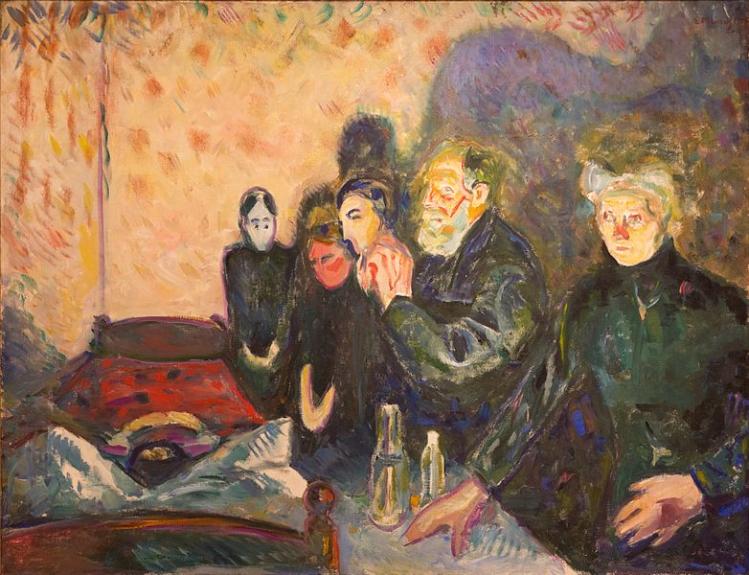
In the third act of Richard III, Sir William Catesby tells Lord Hastings: “’Tis a vile thing to die, my gracious lord, when men are unprepared and look not for it.” Although written around 1592, Catesby’s words still ring true today. Many of us are not prepared for our own deaths. In fact, death remains a topic that makes most of us so anxious and unsettled that we spend much of our lives avoiding the subject entirely. Complicating matters even further is that we live in a culture that shields us from death with the use of euphemisms, such as he “passed away” or she “lost” her husband, rather than the word died.
British palliative-care physician Kathryn Mannix has spent more than thirty years working with the terminally ill. She wants us to regain “the familiarity we once had” with dying because “death itself has become increasingly taboo.” Often separated from loved ones and familiar surroundings, we “now die in ambulances and emergency rooms and intensive care units, our loved ones separated from us by the machinery of life preservation.” Yet all of us will eventually die. So, Mannix decided: “It’s time to talk about dying.” She does just that and much more in her powerful testament to dying well, With the End in Mind: Dying, Death, and Wisdom in an Age of Denial.
Mannix draws us into the world of the dying through stories of her patients. Heart-wrenching and heartwarming at the same time, these poignant tales carry us directly into the core of that mysterious territory we try so hard to avoid. Her stories are not for the faint. Mannix spares no details of the physical and emotional toll the dying process takes on both patients and their support systems. Yet she does so in such an eloquent and tender manner that we do not object to being transported into the private worlds of the terminally ill. Instead, we are inspired and uplifted by these ordinary people and how they deal with the extraordinary pressure of trying to live while they know they are dying. Questions about suffering, meaning, fear, and transcendence emerge on every page. By the end of the book we have learned that while the dying process itself is generally predictable and comfortable, we can make certain choices to increase the likelihood that our life journeys will finish well.
With few medical details omitted, Mannix does not sugarcoat the dying process. She describes sitting with “people while they wept or stared blankly into a future they could barely contemplate.” Her descriptions of deathbed scenarios are quite graphic and at times, even difficult to read. She is so adept, however, at weaving these stories together that I felt as if I were actually in the patients’ rooms, sitting beside them, sensing what they were feeling. There are victories here but no survivals. Still, each thread of Mannix’s tapestry represents courage, acceptance, resilience, forgiveness, and transformation.
The stories of Mannix’s patients are as varied as the illnesses that kill them. We learn about Louisa, who collapses while shopping for a wedding dress for her daughter. Diagnosed with aggressive bone cancer, she is forced to use a wheelchair but is determined to live long enough to attend her daughter’s wedding. On that special day, Louisa is able to hoist herself up with a walker so she can walk with her daughter to the limousine and escort her to her wedding. In another story, we meet an elderly man critically ill with advanced intestinal cancer. He has been living in Rotterdam for years but returns to England to die because he feels subtle yet increasing pressure from Dutch doctors to use euthanasia, legal in the Netherlands. But he does not want that option. Instead, he prefers to spend as much time as possible with his wife and daughter. Mannix is able to keep him comfortable as he lives for another two months surrounded by his loved ones.
The story of Sylvie, a nineteen-year-old dying of leukemia, moved me most. Determined to sew a patchwork cushion cover, she carefully chooses fabrics from her own clothes—an old sun dress, a button from a school uniform, part of a favorite t-shirt. The cover is for the seat cushion of her mother’s rocking chair so that after her death, Sylvie explains, her mother can sit in the chair and “I can rock her, and she can feel my arms around her.”
Even medical professionals can benefit from reading this book. Mannix, who is also trained in cognitive behavioral therapy, has valuable insights into how to interact with terminally ill people and their caregivers. She has learned when to speak, when to listen, when to confront, when to comfort. Her observational skills about her patients’ anxieties, fears, and wishes offer effective lessons on how to approach delicate subjects such as treatment plans, treatment withdrawal, and various family issues. Most of all, Mannix has an inspirational passion for this challenging profession. Her work is not merely a job. It is a vocation, akin to being a midwife on the other end of life. “We are the deathwives,” she says, “and it’s a privilege every time.”
After following the journeys of Mannix’s patients, I found myself in awe of their courage while at the same time wondering: Can I be that brave at the end of my life? But the author reminds us that “these are just ordinary people, like the rest of us, but they are at an extraordinary place in their life journey.” While not perfect “they are examples of what we can all become: beacons of compassion, living in the moment, looking backwards with gratitude and forgiveness, and focused on the simple things that really matter.”
In today’s world of medical technology, it has become easier to live longer but more difficult to die well. Mannix’s book offers us lessons, not just on dying, but also on living. She beautifully illustrates how the awareness of our deaths can bring meaning and purpose to our lives.
With the End in Mind
Dying, Death, and Wisdom in an Age of Denial
Kathryn Mannix
Little, Brown and Company, $27, 352 pp.
Please email comments to [email protected] and join the conversation on our Facebook page.
Previous Story
Christmas Critics
Next Story
Beyond the Bright Lights


